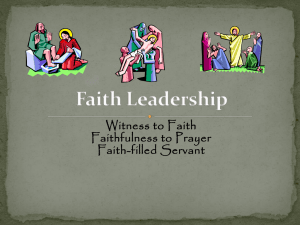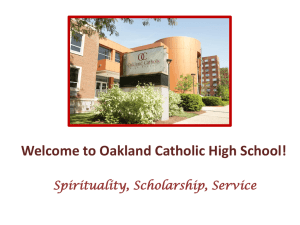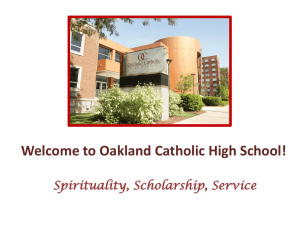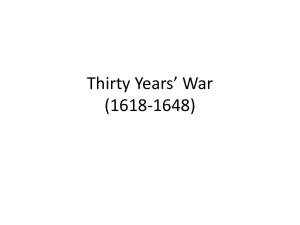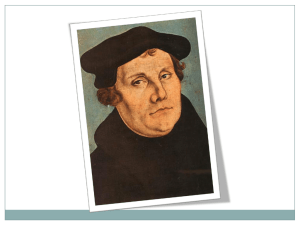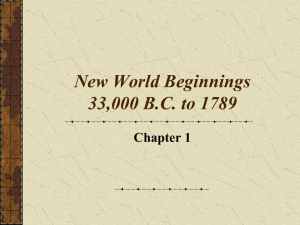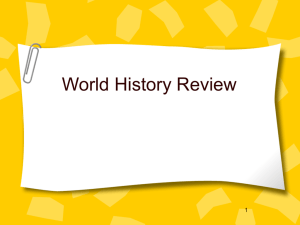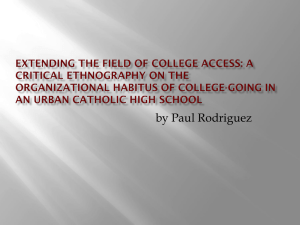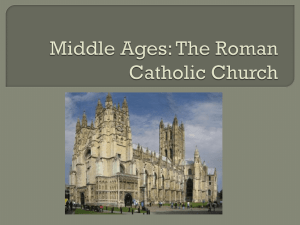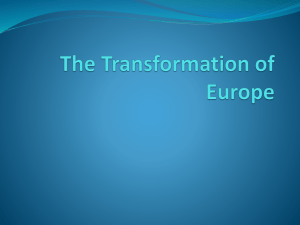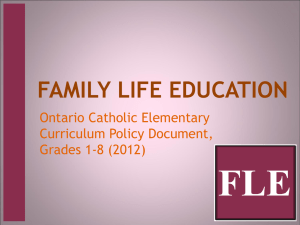Session 3 PGoldburg JGleeson Good Practice
advertisement
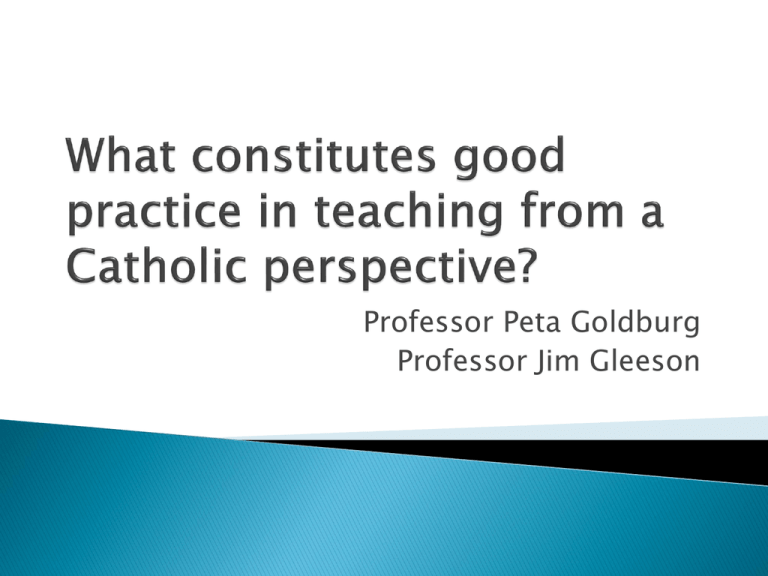
Professor Peta Goldburg Professor Jim Gleeson synthesis of ◦ culture and faith ◦ faith and life ◦ all subjects contribute to development of a mature Christian Educating to intercultural dialogue in Catholic Schools: Living in harmony for a civilisation of love ◦ The curriculum is how the school community makes explicit its goals and objectives, the content of its teaching and the means for communicating it effectively. ◦ In the curriculum, the school’s cultural and pedagogical identity are made manifest Catholic schools are encouraged to promote a wisdom-based society, to go beyond knowledge and educate people to think, evaluating facts in the light of values. …it must also consider the cultural and pedagogical fundamentals that make up Catholic schools’ identity. Catholic schools …should express themselves with authenticity, without obfuscating or watering down their own vision so as to acquire greater consensus. They should bear witness by means of their own presence, as well as by the coherence between what they say and what they do. What do we mean when we say… ◦ ◦ ◦ ◦ ◦ ◦ ◦ ◦ Catholic Religious dimensions of learning Catholic Identity Curriculum Catholicity Gospel Values Catholic Worldview Catholic Curriculum Separation Permeation Integration Where study of religion or religious experience functions as a separate area of learning Goal – religious literacy, formation, explicit religious materials Religious Education (classroom) Curriculum writing easy – experts in RE School-wide task Role of Catholic School’s culture Curriculum = educational experiences planned and guided by school Learning takes place in classroom and beyond classroom Particular focus on social environment of school Curriculum writing - explicit religious framework – task is school wide rather than subject-specific Cross-Curricular Task Difficult because: ◦ Integration shifts away from subject matter to the connections, relationships and life problems in complex world. Curriculum is described as interdisciplinary or trans-disciplinary ◦ Integration broadens the definition of curriculum to include knowledge, values and skills that bring about a critical perspective on social and global issues ◦ carries the capacity to develop curriculum that visibly demonstrates a Catholic character of learning Connected Nested Fragmented Immersed Different approaches to integration (Beane, 1997) Sequenced Integrated Threaded Webbed Shared What have all of these got in common?? Time Monday Tuesday Wednesday Thursday Friday 9:00 History Maths English Geography Religion 9:40 Irish CSPE SPHE Maths Science 10:20 B 10:40 Music Irish History Art Geography 11.20 Business Science Maths French German 12:00 PE Religion German English Business 12:40 L R E U K N C H 1:30 Maths Business Computers Science Maths 2:10 Art Music French Irish English 2:50 Geography English Art Music PE Intra-disciplinary e.g. social justice aspects highlighted within my own subject discipline Multidisciplinary where a common theme is addressed from varying subject perspectives while subject knowledge and skills remain the primary concern Interdisciplinary where skills, concepts, themes are embedded in disciplines and/or standards Trans-disciplinary where students’ questions and issues are the starting point with interdisciplinary and subject skills being applied in a real-life context Interdisciplinary and trans-disciplinary integration are organic whereas multidisciplinary can be ‘forced’ ‘Problems arise when religious concepts and ideas are forced into subject areas with little regard for the integrity of the academic discipline itself. To develop a unit on “journeys” from the different program areas of language, self and society, and religion allows for an authentic curriculum fit. To state, explain and use the Pythagorean theorem and then instruct teachers to tell students that Pythagoras was interested in religion does not’ (Larry Trafford, York University) Course Profiles for various subjects built around the Ontario Curriculum Expectations with overlay of Graduate Expectations Ontario Catholic School Graduate Expectations Curriculum maps, grounded in RE and Family Life programme to help make the Catholic context visible in various subjects (Co-ops) Other, including Catholic Critical Literacy principles e.g. the preferential option for the poor; Critical Thinking Tasks A discerning believer formed in the Catholic faith community who celebrates the signs and sacred ministry of God’s presence…. An effective communicator who speaks, writes, listens honestly and sensitively, responding critically in light of gospel values A reflective, creative and holistic thinker who… makes responsible decisions with an informed moral conscience for the common good. A self-directed, responsible, lifelong learner… A collaborative contributor who finds meaning, dignity and vocation in work which respects the rights of all and contributes to the common good A caring family member A responsible citizen who gives witness by promoting peace, justice and the sacredness of human life. Central Office has three staff including Director Curriculum maps are developed by three regional Curriculum Cooperatives made up of members of Catholic school boards and curriculum consultants who come together to share ideas. Each Cooperative has four curriculum councils: Elementary, Secondary, Technology, Faith Course Profiles are developed in collaboration with the Ontario Ministry Professional development materials that help teachers implement state prescribed secondary curricula while supporting the Ontario Catholic School Graduate Expectations They act as a “map” for teachers – disciplinespecific learning; rationale; organizational structure; teaching, learning and assessment strategies; instructional resources and materials. Whereas the Ministry Curriculum policy documents describe the “what” of learning and teachers are expected to provide the “how” of learning, Course Profiles articulate the “why” of learning. To limit curriculum to Ministry definitions … is to reduce curriculum to little more than society’s latest educational menu, solely pragmatic and utilitarian in nature, and void of any effective and convincing interpretation of existence… …Catholic curriculum is a distinctive worldview committed to the enterprise of educating the soul (Ontario Institute, 1998). Catholic Curriculum Maps are a planning tool that engage teachers in Catholic schools to evaluate their current instructional practices. Clear connections between the key concepts of the curriculum and the key concepts of the Religious Education and Family Life Education programs for the grade level How the content and skills taught in the curriculum are aligned to the Religious Education and Family Life Education programs for the grade level How the overarching Catholic themes and essential questions hold the curriculum together and guide teacher instruction to help students look at the world through a Catholic lens Opportunities that allow students to demonstrate their understanding of the content and skills All texts are constructions - What attitudes, interpretations and conclusions has the author built into the text? - How might the texts be changed to recognize or include missing voices, especially the marginalized? alternative perspectives, including a faith perspective? All texts contain belief and value messages - What lifestyles, values, and points-of-view are represented in, or have been omitted from, the message of the text? - Are these consistent with Catholic teaching? Each person interprets messages differently - How might age, culture, life experiences, values, and beliefs play a role in how this text is interpreted? - How might our faith (prior knowledge and experiences) influence how the message is interpreted? Texts serve different interests - What is the author’s motive/intent? - Who benefits if the message is accepted? Who may be disadvantaged? - Does the purpose have any ethical implications? Each medium develops its own “language” in order to position readers/viewers in certain ways - How have the distinctive techniques, conventions and aesthetics been used to create meaning? - Do these techniques lead the viewer to a life affirming, realistic view of the world? The ‘Defining Characteristics of Catholic Schools’ Center for Catholic School Effectiveness, School of Education, Loyola University National Standards and Benchmarks for Effective Catholic Elementary and Secondary Schools, Loyola Catholic Identity Defining Characteristics Staff Survey (Loyola) Freire - there is no such thing as a neutral educational process. ◦ “Education either functions as an instrument that is used to facilitate the integration of the younger generation in to the logic of the present system and bring about conformity to it, or it becomes ‘the practice of freedom’ the means by which men and women deal critically and creatively with reality and discover how to participate in the transformation of their world.” Requires one to be moved to do something, whether that something be seeking reasons or seeking social justice Not enough that you can critically reflect and interpret the world – you must also be willing and able to act to change that world Changing thought and practice must occur together; they fuel one another Freire – criticality requires praxis – reflection and action; interpretation and change Reading the world as well as reading the word Critical Pedagogy - how an issue relates to "deeper" explanations ◦ relational and dialogical Critical Thinking emphasises immediate reasons and assumptions of an argument Critical Pedagogy wants to consider factors that may appear at first of less immediate relevance How has this session changed any of your beliefs about infusing the explicit curriculum with Catholic perspectives? What action might you take in light of this? What are implications for policy at various levels?
